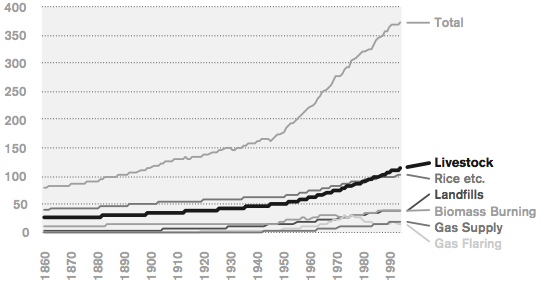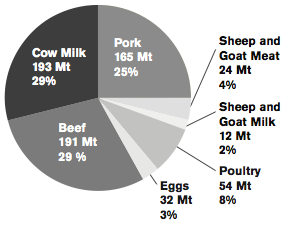Climate Change
UNFCCC had once mainly focused mitigation. However, the importance and urgency of adaptation policy have gained collective interests recently as climate change has proven inevitable even if mitigation policy is on track. Recently UNFCCC has come to Cancun Agreements during 2010 United Nations Climate Change Conference affirming that global average temperature will be at least 1.5 degrees higher than pre-industrial level. The Agreements was in fact based on the projection of the fourth assessment report of IPCC, that projected global warming during the 21st century would be ranged from 1.8 to 4.0 degrees, 1 which is even higher than what UNFCCC and Cancun Agreements stated.
Two strategies of the climate change policy
The climate change policy today can be categorized into two strategies; mitigation and adaptation. While the effort to reduce greenhouse gases – mitigation — should be continued, the ecosystem including human society would have to seek ways to adjust to the changing climate and to avoid potential dangers from it — adaptation. 2 3 The growing demand on beef is giving burden to global warming mitigation strategy and will continue to worsen the food crisis in near future and make the adaptation more difficult than already expected to be.
Mitigation
Deforestation around the Amazon particularly accelerates global warming and it is mainly resulted from cattle breeding expansion and soybean production. According to studies, 80% of deforestation of the Amazon is happening in Brazil and cattle ranching are the driving reason. 4 Moreover, enteric fermentation from livestock ranching, especially cattle, is the most contributing source of methane that has 12 times higher greenhouse effect than carbon di- oxide. Several studies estimate the amount of methane emitted from ruminants is larger than that from emission from coal mining, landfills, or even gas and oil industry, 5 and therefore reducing demand on beef at large remains crucial to mitigate global warming.
Adaptation
It is estimated that about 15-40% of species will collapse with 2℃ of warming, and the extinction rate will be an half of all species with 4℃. Additionally crop yield will decline substantially as temperature rises over 2℃. 6 Regarding that the temperature already has risen up by 0.8℃ since 1850, human basic needs such as food and energy would be seriously threatened in the near future. The impact will spread into all aspects of human living, and ultimately it will alter the system of our society as a whole.

Global Anthropogenic Methane Emissions: 1860-1994, (Stern & Kaufmann)
In a FAO report in 2006, Livestock’s Long Shadow, it is found that livestock are responsible for 18 percent of global greenhouse gas (GHG) emissions, a share higher than that contributed by all transportation. 7 In addition, livestock account for 37 percent of global emissions of methane, a GHG with 23 times the global warming potential (GWP) of carbon dioxide, and 65 percent of emissions of nitrous oxide(NO2), another powerful GHG with 298 times stronger impact ‘per unit 50 weight’ than CO2 considered over a 100-year period. Beef production in particular appears to have greater impact on climate change than any other animal products.

Non-CO2 GHG emissions associated with the production of various food items. Units are 106 CO2-eq yr−1, except column 63
*Source: US Department of Energy 8
It has already been six years after the aforementioned FAO report was published, and the figures widely accepted within the report seem to be somewhat conservative to what is being argued afterwards. In a paper published by a respected US thinktank, the Worldwatch Institute, two World Bank environmental advisers claimed that instead of 18 per cent of global emissions being caused by meat, the true figure is 51 per cent. 9 Robert Goodland, a former lead environmental adviser to the World Bank, and Jeff Anhang, a current adviser, suggested that domesticated animals cause 32 billion tons of CO2-eq., definitely much more than the impact of all transportation, and more than that of industry and energy. Goodland and An- hang argues ‘if this argument is right, it implies that replacing livestock products with better alternatives would be the best strategy for reversing climate change. In fact, this approach would have far more rapid effects on greenhouse gas emissions and their atmospheric concen- trations than actions to replace fossil fuels with renewable energy.’
Other scientists are concerned about livestock’s exhalation of methane, which cows and other ruminants are responsible for 37 per cent of the world’s emission. The Independent reported that a study by Nasa scientists published in Science in 2009 found that methane has signifi- cantly more GWP than previously thought: 33 times more than carbon dioxide, compared with a previous factor of 25. 10
European Peculiarity

EU Total Livestock GHG fluxes EU27: 661 Mt CO2-eq. Total GHG fluxes of EU-27 livestock production in 2004, calculated with a cradle-to-gate lifecycle analysis with CAPRI
In Europe, where dairy consumption per capita is high- er than any other region, meat consumption is not the only contributor to climate change. Total GHG fluxes of European livestock production including land use change emissions amount to 661 Metric Tonne(Mt) CO2-eq. 29% are from beef production, 193 Mt CO2-eq. (29%) from cow milk production and 165 Mt CO2-eq. (25%) from pork production, while all other animal products together do not account for more than 111 Mt CO2-eq. (17%) of total emissions. 11
Tipping point – Vicious Circle of Global Warming
The warming doesn’t happen equally to all the regions. The temperature at the poles is around 4 degrees Celsius warmer than pre-industrial levels — much higher compared to the global average of 0.8, which will melt away permafrost in polar regions, which will all the more ac- celerate global warming due to the darker color of the surface and potentially growing threat of bubbling methane in the Arctic Ocean and Siberian swamps.
One day in 2007, on the plain in northern Alaska, a lightning strike set the tundra on fire. Historically, tundra, a landscape of lichens, mosses and delicate plants, was too damp to burn and no fire of that scale had occurred in the region in at least 5,000 years. But the climate in the area is warming and drying, and fires in both the tundra and forest regions of Alaska are increasing. Scientists say the fire thawed the upper layer of permafrost and set off what they fear will be permanent shifts in the landscape. Up to now, the Arctic has been absorbing car- bon, on balance, and was once expected to keep doing so throughout this century. But recent analyses suggest that the permafrost thaw could turn the Arctic into a net source of carbon, possibly within a decade or two, and those studies did not account for fire. 12
Posted by Seungho Lee
References
- IPCC, Climate Change 2007: The Physical Science Bases. Contribution of Working Group I to the Fourth Assessment Report, Cambridge University Press, Cambridge, 2007, p.13 & pp. 539-542. ↑
- J McCarthy, OF Canziani, NA Leary, DJ Dokken & KS White (ed.), Climate Change 2001: Impacts, Adaptation and Vulnerability, Cambridge University Press, Cambridge, 2001 ↑
- T Tanner & J Allouche, Towards a New Political Economy of Climate Change and Development, IDS Bulletin. 32 (3), 2011, pp. 1-14. ↑
- Y Malhi, JT Roberts, RA Betts, TJ Killeen, W Li & CA Nobre, Climate Change, Deforestation, and the Fate of the Amazon, Science, 319, 2008, pp. 169-172. ↑
- IPCC, loc. cit. ↑
- N Stern, The Economics of Climate Change: The Stern Review, Cambridge University Press, New York, 2007, pp. 65-68. ↑
- LEAD (Livestock, Environment and Development), Livestock’s Long Shadow: Environmental Issues and Options, FAO (Food and Agricultural Organization of the UN), Rome, 2006. ↑
- US Department of Energy, Annual energy review 2003, Rep. DOE/EIA-0384(2003), Energy Information Administration, p. 390. ↑
- R Goodland & J Anhang, Livestock and Climate Change: What if the key actors in climate change are cows, pigs, and chickens?, World Watch, November/December 2009, Washington DC, 2009. ↑
- M Hickman, ‘Study claims meat creates half of all greenhouse gases’, The Independent, 1 November 2009, re- trieved 28 November 2011, link. ↑
- A Leip, F Weiss, T Wassenaar, I Perez, T Fellmann, P Loudjani, F Tubiello, D Grandgirard, S Monni & K Biala, Evaluation of the livestock sector’s contribution to the EU greenhouse gas emissions (GGELS), European Commission, Joint Research Centre, 2010, p. 18. ↑
- J Gillis, ‘As Permafrost Thaws, Scientists Study the Risks’, The New York Times, 16 December 2011, retrieved 6 April 2012, link. ↑